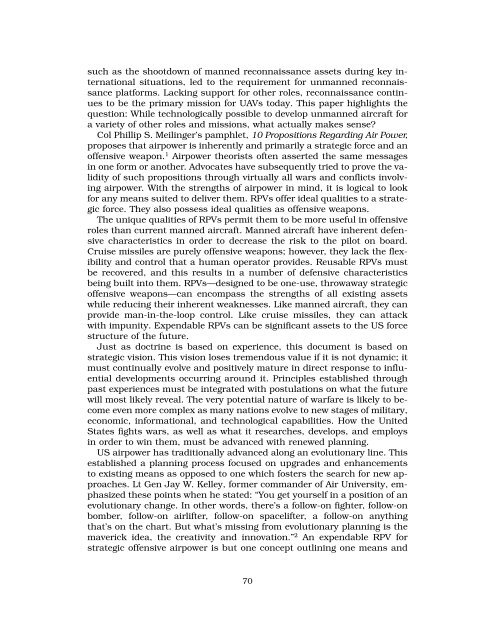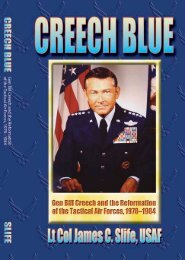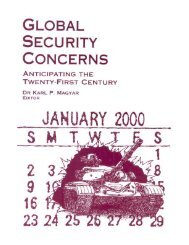Expendable Remotely Piloted Vehicles for Strategic Offensive ...
Expendable Remotely Piloted Vehicles for Strategic Offensive ...
Expendable Remotely Piloted Vehicles for Strategic Offensive ...
Create successful ePaper yourself
Turn your PDF publications into a flip-book with our unique Google optimized e-Paper software.
such as the shootdown of manned reconnaissance assets during key internationalsituations, led to the requirement <strong>for</strong> unmanned reconnaissanceplat<strong>for</strong>ms. Lacking support <strong>for</strong> other roles, reconnaissance continuesto be the primary mission <strong>for</strong> UAVs today. This paper highlights thequestion: While technologically possible to develop unmanned aircraft <strong>for</strong>a variety of other roles and missions, what actually makes sense?Col Phillip S. Meilinger’s pamphlet, 10 Propositions Regarding Air Power,proposes that airpower is inherently and primarily a strategic <strong>for</strong>ce and anoffensive weapon. 1 Airpower theorists often asserted the same messagesin one <strong>for</strong>m or another. Advocates have subsequently tried to prove the validityof such propositions through virtually all wars and conflicts involvingairpower. With the strengths of airpower in mind, it is logical to look<strong>for</strong> any means suited to deliver them. RPVs offer ideal qualities to a strategic<strong>for</strong>ce. They also possess ideal qualities as offensive weapons.The unique qualities of RPVs permit them to be more useful in offensiveroles than current manned aircraft. Manned aircraft have inherent defensivecharacteristics in order to decrease the risk to the pilot on board.Cruise missiles are purely offensive weapons; however, they lack the flexibilityand control that a human operator provides. Reusable RPVs mustbe recovered, and this results in a number of defensive characteristicsbeing built into them. RPVs—designed to be one-use, throwaway strategicoffensive weapons—can encompass the strengths of all existing assetswhile reducing their inherent weaknesses. Like manned aircraft, they canprovide man-in-the-loop control. Like cruise missiles, they can attackwith impunity. <strong>Expendable</strong> RPVs can be significant assets to the US <strong>for</strong>cestructure of the future.Just as doctrine is based on experience, this document is based onstrategic vision. This vision loses tremendous value if it is not dynamic; itmust continually evolve and positively mature in direct response to influentialdevelopments occurring around it. Principles established throughpast experiences must be integrated with postulations on what the futurewill most likely reveal. The very potential nature of warfare is likely to becomeeven more complex as many nations evolve to new stages of military,economic, in<strong>for</strong>mational, and technological capabilities. How the UnitedStates fights wars, as well as what it researches, develops, and employsin order to win them, must be advanced with renewed planning.US airpower has traditionally advanced along an evolutionary line. Thisestablished a planning process focused on upgrades and enhancementsto existing means as opposed to one which fosters the search <strong>for</strong> new approaches.Lt Gen Jay W. Kelley, <strong>for</strong>mer commander of Air University, emphasizedthese points when he stated: “You get yourself in a position of anevolutionary change. In other words, there’s a follow-on fighter, follow-onbomber, follow-on airlifter, follow-on spacelifter, a follow-on anythingthat’s on the chart. But what’s missing from evolutionary planning is themaverick idea, the creativity and innovation.” 2 An expendable RPV <strong>for</strong>strategic offensive airpower is but one concept outlining one means and70






